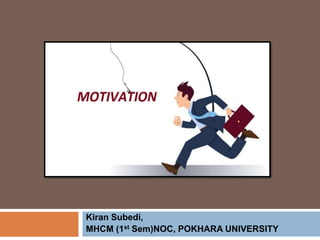Motivation
- 1. Kiran Subedi, MHCM (1st Sem)NOC, POKHARA UNIVERSITY
- 2. Meaning of motivation Motivation is derived from the Latin word ‘movere’ which means ‘to move’ or ‘to energize’ or ‘to activate’. Motivation is a need or desire that energizes and directs behavior.
- 3. Key Elements 1. Intensity: how hard a person tries 2. Direction: toward beneficial/avoidance goal 3. Persistence: how long a person tries Motivation is a psychological feature that induces an individual to act towards a desired goal. It is the processes that account for an individual’s intensity, direction, and persistence of effort towards attaining a goal. What is Motivation ?
- 4. Definition Motivation refers to the states within a person or animal that drives behavior toward some goals. - MORGAN AND KING Internal and external factors that stimulate desire and energy in people to be continually interested and committed to a job, role or subject, or to make an effort to attain a goal. - Business dictionary
- 5. Motivation results from the interaction of both conscious and unconscious factors such as the (1) intensity of desire or need, (2) incentive or reward value of the goal, and (3) expectations of the individual and of his or her peers. These factors are the reasons one has for behaving a certain way. An example is a student that spends extra time studying for a test because he or she wants a better grade in the class.
- 6. Features of motivations Motivation is an internal feeling Motivation produces goal directed behavior Motivation contains systems orientation Motivation can either be positive or negative Motivation is different from job satisfaction
- 7. Importance of Motivation High Performance Productive use of resources Low employee turnover and absenteeism rate Better quality orientation Achievement of goals Development of friendly relationships Increase efficiency and outputs
- 8. Types of motivation a. Extrinsic Motivation Extrinsic motivation means that the individual's motivational stimuli are coming from outside. In other words, our desires to perform a task are controlled by an outside source. Note that even though the stimuli are coming from outside, the result of performing the task will still be rewarding for the individual performing the task. b. Intrinsic Motivation Intrinsic motivation means that the individual's motivational stimuli are coming from within. The individual has the desire to perform a specific task, because its results are in accordance with his belief system or fulfills a desire and
- 9. •Extrinsic Motivation. 1. Salary. 2. Bonuses/Perks. 3. Organized activities. 4. Promotion/Grades. 5. Punishment/Layoffs •Intrinsic Motivation: 1. Learning and Growth opportunity. 2. Social contact and status. 3. Curiosity 4. Respect and Honors.
- 10. Types of Motivation. Extrinsicall y Motivated. Intrinsically Motivated.
- 11. Theories of motivation •Content Theories of Motivation: 1.Mc Gregor’s Theory X & Theory Y (1960) 2.Maslow’s Hierarchy of Needs (1943, 1954) 3.Hertzberg’s Motivator-Hygiene Theory (1968) 4.Alderfer’s ERG Theory (1972) •Process Theories of Motivation. 1.Expectancy Theory, Vroom (1964) 2.Equity Theory , Adam (1963) 3.Goal Setting Theory, Edwin A Locke (1968) 4.Reinforcement Theory, Skinner(1953)
- 12. Maslow’s hierarchy of needs
- 14. Theory X and Theory Y
- 16. Communications and motivations All communications, intentional or unintentional, have some effect. The purpose could be to generate action, inform, create understanding or communicate a certain idea/point etc. Communication role enactment reflects motivational patterns Motivational managers are most be flexible.
- 17. Role of Communication in Employee Motivation Employee motivation is critical to maintaining productivity. There are several factors that influence motivation, including pay, career opportunities and positive relationships with co- workers. Business owners and managers also need to understand the role of communication in employee motivation, as it can sometimes be the most basic communication errors that lead to employee dissatisfaction. Facilitating effective communication can help improve employee motivation in several ways.
- 18. Role of Communication in Employee Motivation Relationships Information Distribution Decision-Making Improvement
- 19. Information Distribution The company should distribute information that employees consider vital, such as changes in the company's business focus or planned changes in the workforce, unless that information is company confidential. For example, if employees inquire into the validity of a rumor that the company will be shutting down for an extra day during the winter holidays, the best response is for management to distribute accurate information immediately. This not only makes the employees feel respected by the company, it also helps combat rumors that can lead to morale problems. Relationships A workplace operates on the effective relationships built between employees, managers, departments and all levels of the company. Clear and honest communication helps to encourage and strengthen those relationships, which can assist employees in reaching maximum productivity. For example, company managers can maintain a productive relationship with staff members by holding regular departmental meetings and sponsoring employee career development programs where management personnel monitor and assist in employees' progress. Maintaining strong workplace relationships helps employees achieve high levels of productivity and supports staff motivation.
- 20. Decision-Making A company's decision-making process includes active communication throughout the organization. Employees should be allowed as many ways as possible to offer their ideas and opinions, and be part of the decision-making process. For example, a company suggestion box can be actively monitored by management and when an employee suggestion is used, that employee given credit in the monthly company newsletter. Open communication allows employees to be a part of company decision-making and participate in the company's success. Improvement Skill set training programs with managers is the way in which most employees receive their career development assistance. If managers are not monitoring employee performance and developing training programs to improve productivity, then the skill sets of the employees begin to suffer. Communication between the employee and manager, as well as the employee and human resources, is critical in developing training programs that improve the employee's job skills and motivate her to succeed.

